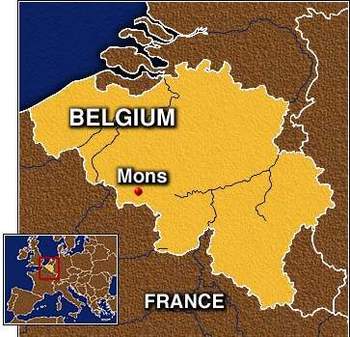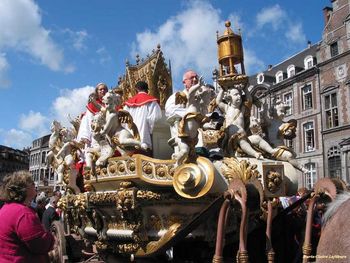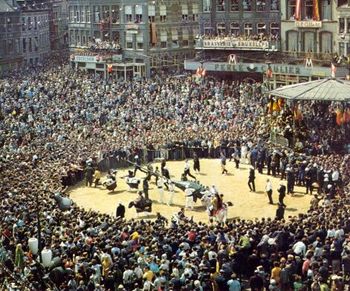Doudou
The Doudou or Ducasse de Mons is a festival organized on the Trinity Sunday (57 days after Easter) in the city of Mons (in Walloon – Mont, Dutch - Bergen). Mons has a population of 92,523 (2011). It is located in the Belgian province of Hainaut.
 location of Mons, Belgium
location of Mons, Belgium
The festival has two parts. The first one is the procession honouring the descent and the uprising of the Waltrude’s Shrine. Saint Waltrude (in Walloon - Waudru, Dutch - Waldetrudis) is the patron saint of Mons. The second part of the festival is The Combat of Saint George or Lumeçon.
The Doudou has its origin in the Middle Ages. The plague appeared in Mons in 1349. City authorities organized a procession with the Waltrude's shrine. The shrine was brought to a little village of Casteau located between Mons and Soignies. At the same time the shrine of Waltrude's husband Vincent Madelgarus was moved from Soignies to Casteau. After this procession the miracle happened. The plague disappeared.
In 1352 church authorities decided that this miracle should be honoured on the Trinity Sunday. Famous fraternity of Saint George joined the procession after 1380. This fact meant the separation of religious and non religious part of the festival. The non religious part was the reconstitution of the combat between Saint George and a Dragon.
The procession was organized continuously since that time. The only exceptions were 1803 and periods during World War 1 and 2.
The Doudou lasts from the Saturday before Trinity Sunday till the next Sunday. This period is called an octave.
The Shrine is taken down from his Altar on the Saturday evening. The shrine is given by the priest to the city authorities. They keep it during the festival. The procession starts with people holding torches.
The start of the next procession is in the morning of Trinity Sunday. The shrine is put on the golden dray (wagon) or "Car d'Or" and pulled through the city by draft horses. These draft horses are bred to perform hard tasks.
 Mons Car d'Or
Mons Car d'Or
The dray is accompanied by several historical guilds. Guild is the union of people connected for example by the same line of business. Guild is a combination between a trade union, a cartel and a secret society.
The final stage of this procession is the most difficult. The dray has to move up the very steep, cobblestoned street called Rampe Sainte-Waudru. To help the horses hundreds of people push the dray. If they do not succeed the whole city will suffer in the future.
At the end of festival the shrine is returned back to the church authorities in a ceremony called the ascent of the shrine.
The second, secular part of the Doudou is held between 0.30 pm and 1.00 pm on the Trinity Sunday. The event represents the fight between Saint George (the good) and the dragon (the evil). The event is also called Lumeçon. The word is derived from French Limaçon which used to be an event with horses that made circular movements.
 Lumeçon
Lumeçon
The battle is held at the central city square. The figure of dragon is about 10 meters long. There is some horse's hair ("mane") on its tale. Group of white men (in French "hommes blancs") moves the dragon. Saint George is protected by the Chinchins representing dogs.
 group of white men moves the dragon
group of white men moves the dragon
The devils (in French "les diables") help the dragon. They use the balloon which was traditionally made of cow bladder. Today they are made of plastic. Balloons are devils' weapons. They use them to knock the Chinchins or someone in the audience watching the battle. So, all of you planning to attend the event be careful.
The dragon uses its tail to attack Saint George and people in the audience. They try to steal the mane in dragon's tail. It is believed that this reduces dragon's luck.
The battle also includes Leaf men (in French Hommes de feuilles). They are called so as their body is covered with real ivy leaves. They defend the dragon.
Moves of those involved in the battle are precisely determined. Saint George on his horse turns in the clockwise direction. The dragon moves in the opposite way. This should symbolize the difference between good and evil.
Saint George uses his lance to kill the dragon but he does not succeed. He kills the dragon in the third attempt with his pistol.
The battle is over at 1.00 pm. The participants leave the arena. People from the audience rush in to find some lucky "mane" left on the floor after the battle. Sound of the musical instrument called carillon signals the end the battle.
Several other events accompany the Doudou. On the Friday evening before Trinity Sunday there is a big concert. Military bands from all over the world perform at the main city square. Street clearance sale is organized on Monday. Lighter version of the above mentioned battle is organized for kids on Wednesday. As always during such festivals lot of traditional food and beverage is available for visitors.